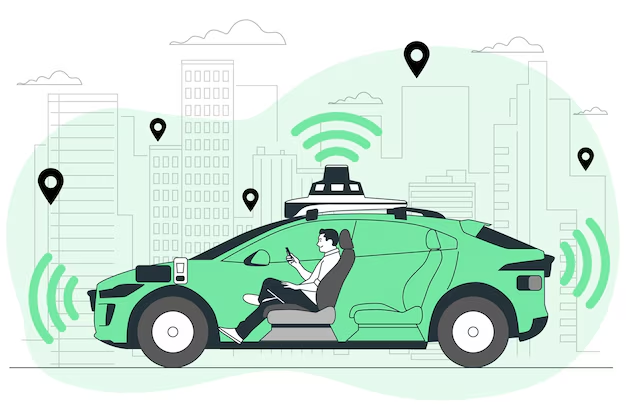The development of autonomous vehicles (AVs) has quickly become one of the most exciting and transformative fields in modern technology. As the automotive industry moves toward self-driving cars, there is an increasing need for systems that can handle vast amounts of data in real time, make split-second decisions, and ensure safety and reliability. One technology that has proven indispensable in meeting these challenges is the Field-Programmable Gate Array (FPGA).
FPGAs, known for their reconfigurable hardware and parallel processing capabilities, are playing a critical role in the development of autonomous vehicles. These versatile devices are capable of processing data from multiple sensors, including cameras, LiDAR, and radar, simultaneously and with low latency—critical factors for enabling real-time decision-making. Furthermore, their ability to be customized for specific tasks, from sensor fusion to machine learning acceleration, makes them an ideal fit for the evolving demands of autonomous vehicle systems.
In this article, we will explore the role of FPGAs in autonomous vehicle development, examining their unique advantages, key applications, and how they integrate with other technologies to help create safer, more efficient, and more reliable self-driving cars.

Why FPGAs Are Ideal for Autonomous Vehicle Systems
Autonomous vehicles (AVs) rely on a combination of advanced sensors, complex algorithms, and real-time decision-making systems to navigate and interact with their environments safely. FPGAs (Field-Programmable Gate Arrays) have emerged as an ideal solution for meeting the unique challenges posed by autonomous vehicle technology. Their flexibility, parallel processing capabilities, low latency, and power efficiency make them particularly well-suited for AV applications. Here’s why FPGAs are such a critical enabler for autonomous vehicle systems:
1. Parallel Processing Capabilities
One of the standout features of FPGAs is their ability to execute many tasks simultaneously. In the context of autonomous vehicles, this ability is crucial for processing data from multiple sensors in real time. AVs rely on a combination of sensors such as cameras, radar, LIDAR, and ultrasonic sensors to create a comprehensive view of the surrounding environment. These sensors generate massive amounts of data that need to be processed concurrently, especially when the vehicle is navigating complex and dynamic environments.
FPGAs excel in parallel processing, allowing them to handle multiple data streams at once. This capability enables AV systems to process inputs from various sensors simultaneously, making real-time decision-making possible without delays, a critical factor for ensuring the safety and reliability of autonomous driving systems.
2. Reconfigurability for Customization
FPGAs are highly reconfigurable, meaning their hardware can be customized to perform specific tasks required by the autonomous vehicle system. Unlike traditional processors, which have fixed hardware configurations, FPGAs allow developers to tailor the design to meet the precise needs of an application.
In autonomous vehicles, the requirements for processing power and performance can change depending on the vehicle’s task. For instance, in one situation, the vehicle may need to prioritize real-time object detection, while in another, it might need to focus on path planning or vehicle-to-vehicle communication. FPGAs can be programmed to perform these diverse tasks efficiently and in parallel, offering flexibility as AV systems evolve and new algorithms and functionalities are integrated.
3. Low Latency for Real-Time Decision Making
In autonomous driving, every millisecond counts when it comes to making decisions. For example, detecting an obstacle in the vehicle’s path and reacting to it must happen instantaneously to avoid a collision. FPGAs offer extremely low latency, meaning they can process inputs and generate outputs without significant delay.
FPGAs are ideal for time-sensitive applications like autonomous driving because their architecture enables direct hardware-based execution of critical algorithms, reducing the time it takes to process data and make decisions. This speed is essential in AVs, where delays in decision-making could lead to dangerous situations.
4. Power Efficiency
Autonomous vehicles require high-performance computing systems that can operate continuously, often over long distances, without draining excessive power. FPGAs are known for their power efficiency when compared to general-purpose processors like CPUs or GPUs. This makes them an attractive option for use in AVs, where power consumption must be carefully managed to ensure long-range operation without compromising the vehicle’s performance.
By optimizing power consumption without sacrificing processing power, FPGAs help to extend the overall energy efficiency of autonomous vehicles, which is essential for electric AVs where battery life is a key concern.
5. Scalability and Integration with Existing Systems
As the autonomous vehicle industry matures, it is expected that vehicle systems will become more complex and integrated with emerging technologies like 5G, machine learning, and advanced communication protocols. FPGAs are scalable and can be easily integrated into existing vehicle platforms without the need for a complete redesign of the system.
FPGAs also complement other processing technologies, such as CPUs and GPUs, allowing for seamless integration into multi-processor environments. This flexibility enables AV manufacturers to use FPGAs in conjunction with other hardware, ensuring that the system can scale and adapt as new features and capabilities are added over time.

Key FPGA Applications in Autonomous Vehicles
FPGAs are playing a pivotal role in enabling autonomous vehicles (AVs) to operate safely, efficiently, and autonomously. Their versatility, real-time processing capabilities, and low latency make them well-suited to tackle the complex tasks involved in autonomous driving. Below are some of the key applications of FPGAs in autonomous vehicle systems:
1. Sensor Fusion
Autonomous vehicles rely on a variety of sensors, including cameras, LIDAR (Light Detection and Ranging), radar, ultrasonic sensors, and more, to gather data about their surroundings. This sensor data must be fused in real time to create an accurate, cohesive understanding of the environment, allowing the vehicle to make informed decisions.
FPGAs excel at sensor fusion due to their ability to process multiple data streams in parallel. By combining data from different sensors, FPGAs help the vehicle construct a comprehensive 360-degree view of its surroundings, identifying objects such as pedestrians, other vehicles, and obstacles. This fused data is crucial for the vehicle to understand its position relative to other objects and make safe driving decisions.
2. Computer Vision
Computer vision is a critical component of autonomous driving systems, enabling vehicles to understand and interpret visual information from cameras. Tasks such as lane detection, object recognition, traffic sign recognition, and pedestrian detection rely heavily on computer vision algorithms.
FPGAs are particularly well-suited for real-time image processing because of their low latency and ability to handle parallel operations. This allows AVs to detect and track objects in the vehicle’s environment, recognizing road signs, other vehicles, and pedestrians with high precision and minimal delay. FPGAs can accelerate machine learning models for computer vision tasks, such as convolutional neural networks (CNNs), enabling faster decision-making and more reliable performance in dynamic environments.
3. Object Detection and Tracking
Accurate object detection and tracking are essential for autonomous vehicles to navigate safely. AVs need to continuously identify and track nearby objects, such as other vehicles, pedestrians, cyclists, and obstacles. This process involves recognizing objects in the vehicle’s environment and predicting their movement to avoid collisions.
FPGAs accelerate object detection algorithms by processing data from multiple sensors in parallel. They can quickly identify and track objects, ensuring that the vehicle can react to sudden changes in the environment, such as a pedestrian crossing the street or another vehicle merging into the lane. By offloading these tasks to FPGA hardware, AV systems can operate with low latency, which is critical for safety-critical applications.
4. Path Planning and Decision Making
Path planning is the process of determining the best route for the vehicle to follow while avoiding obstacles and adhering to traffic laws. In real-time, AVs must make split-second decisions, such as whether to change lanes, stop for a pedestrian, or avoid a potential collision.
FPGAs can accelerate path planning and decision-making algorithms, ensuring that decisions are made rapidly and accurately. Their parallel processing capability allows for complex computations, such as optimizing trajectories and evaluating various potential actions, to be performed simultaneously. With FPGA acceleration, autonomous vehicles can make safe decisions even in the most dynamic and unpredictable environments, where delay could lead to accidents.
5. Vehicle-to-Everything (V2X) Communication
Vehicle-to-Everything (V2X) communication refers to the ability of autonomous vehicles to exchange information with other vehicles, infrastructure, pedestrians, and networks. This communication is essential for improving safety and efficiency on the road by enabling real-time data sharing, such as traffic signal status, road conditions, or nearby hazards.
FPGAs can support V2X communication by handling the complex data transmission protocols required for low-latency, high-reliability communication. With FPGAs, AVs can send and receive information from surrounding vehicles and infrastructure systems, enabling real-time responses to changing road conditions. This capability enhances the safety and intelligence of autonomous driving, as vehicles can respond proactively to external factors.
6. AI and Machine Learning Acceleration
Artificial intelligence (AI) and machine learning (ML) models are increasingly used in autonomous vehicles for tasks such as object detection, decision-making, and predictive analytics. These models require massive amounts of data to be processed and evaluated in real time.
FPGAs are highly effective at accelerating AI and ML models due to their ability to execute computations in parallel. They can significantly speed up the inference phase of machine learning algorithms, allowing the AV system to make quicker decisions. For example, object detection models based on deep learning can be processed more efficiently by FPGAs, enabling real-time analysis of sensor data and faster responses from the vehicle.
7. Control Systems and Autonomous Driving Algorithms
The core of an autonomous vehicle is its control system, which governs the vehicle’s steering, braking, acceleration, and overall movement. These systems rely on complex algorithms to ensure that the vehicle moves safely, smoothly, and in compliance with traffic rules.
FPGAs are used in control systems to process data from various vehicle sensors and make real-time adjustments. For example, the vehicle’s steering system might need to adjust in response to changes in road conditions, such as a sharp turn or a wet surface. FPGAs can handle the computational load required to continuously adjust these systems, allowing the vehicle to operate autonomously with high precision and reliability.
8. Simulation and Testing
Before deploying autonomous vehicles on the road, extensive simulation and testing are essential to ensure that the vehicle’s systems perform as expected in various scenarios. FPGAs are used in simulation platforms to test autonomous driving algorithms under different conditions, such as inclement weather, night driving, or high traffic.
By leveraging FPGA hardware for simulation, manufacturers can create more realistic test environments, speeding up the validation process. The ability to replicate real-world conditions and run parallel simulations on FPGA systems helps accelerate the development cycle for autonomous vehicles, ensuring their safety and reliability before they are deployed in real-world environments.
FPGA Integration with Other Technologies in Autonomous Vehicles
The development of autonomous vehicles (AVs) requires a seamless integration of numerous advanced technologies to ensure that the vehicle operates safely, efficiently, and autonomously. FPGAs (Field-Programmable Gate Arrays) are increasingly being used to complement and enhance other critical technologies in AVs, from sensors and processors to communication networks and machine learning models. This integration allows for a more robust and responsive system that can handle the complex and dynamic demands of self-driving.
Here’s a look at how FPGAs integrate with key technologies in autonomous vehicles:
1. Integration with Sensor Technologies
Autonomous vehicles rely on a diverse array of sensors to gather data about their environment. These sensors—such as cameras, LIDAR (Light Detection and Ranging), radar, and ultrasonic sensors—generate vast amounts of data that need to be processed in real time for decision-making. FPGAs play a vital role in the integration of these sensors by providing the parallel processing power necessary to handle multiple sensor streams simultaneously.
- Sensor Fusion: FPGAs allow for the integration of data from different sensors, processing them concurrently to provide a unified view of the environment. This is essential for tasks like object detection, collision avoidance, and lane detection, where multiple sensor types must work together to give the vehicle a comprehensive understanding of its surroundings.
- Real-Time Data Processing: FPGAs are capable of processing sensor data with low latency, making them ideal for real-time applications such as detecting obstacles, pedestrians, or other vehicles. This integration ensures that AVs can respond quickly to dynamic changes in the environment, which is crucial for safety and navigation.
2. Integration with Machine Learning and AI Models
Machine learning (ML) and artificial intelligence (AI) are core to enabling autonomous vehicles to make decisions based on sensor data. AI algorithms, such as deep learning models for image recognition or reinforcement learning for decision-making, are crucial for tasks like object detection, route planning, and driving strategy.
- AI Acceleration: FPGAs excel at accelerating machine learning models due to their ability to parallelize computations. For example, deep learning models, such as Convolutional Neural Networks (CNNs) used for object recognition, can be offloaded to FPGA hardware for faster processing and inference, reducing the time it takes for the vehicle to make critical decisions.
- Edge Computing: In an autonomous vehicle, real-time decision-making is essential. FPGAs support edge computing by allowing AI and ML models to run directly on the vehicle’s hardware, reducing the dependency on cloud computing and improving response times. This is crucial in safety-critical applications like collision avoidance, where delays can be hazardous.
3. Integration with Communication Systems (V2X)
Vehicle-to-everything (V2X) communication is another critical aspect of autonomous vehicles. V2X allows the vehicle to communicate with other vehicles, infrastructure, pedestrians, and networks to improve safety, traffic flow, and vehicle efficiency.
- Low-Latency Communication: FPGAs help enable the low-latency communication required for V2X systems by handling the complex transmission protocols. This allows autonomous vehicles to send and receive information in real time, such as traffic updates, road conditions, or hazard alerts, helping them adapt to changing conditions and avoid potential risks.
- Enhanced Connectivity: As V2X networks become more advanced, FPGAs can support newer communication standards like 5G, which promises high-speed, reliable, and low-latency connections. FPGAs’ ability to integrate with 5G networks enables AVs to share data faster and with greater reliability, improving the vehicle’s situational awareness and response times.
4. Integration with Control Systems and Actuators
The vehicle’s control systems, including steering, braking, and acceleration, rely on continuous input from various sensors and decision-making algorithms to adjust the vehicle’s movements in real time. FPGAs provide the computational power needed to process this data and make rapid adjustments to the vehicle’s actuators.
- Real-Time Control: FPGAs can be used in the feedback loops of the control systems to ensure that the vehicle responds immediately to changes in its environment. For example, if an obstacle is detected, the FPGA can process the data and send commands to the vehicle’s actuators to avoid a collision within milliseconds.
- Path Planning and Decision Making: Path planning algorithms rely on a variety of inputs, such as road conditions, obstacles, and traffic signals, to determine the best route for the vehicle. FPGAs can integrate with path planning systems to provide real-time adjustments, helping the vehicle maintain an optimal path while reacting to changes in the environment.
5. Integration with Radar, LIDAR, and Computer Vision
Radar and LIDAR are essential for providing the vehicle with depth perception and environmental awareness, while computer vision systems analyze the visual data from cameras to detect objects, lane markings, and traffic signals.
- Sensor Data Processing: FPGAs can integrate with radar, LIDAR, and computer vision systems by processing their data streams in parallel. This capability allows the vehicle to accurately track and detect objects in various conditions, such as low light or inclement weather, where traditional sensors may struggle.
- Fusion and Interpretation: FPGAs enable the fusion of radar and LIDAR data with computer vision data, creating a unified perception model. This helps the AV identify objects in 3D space and makes decisions such as whether to change lanes or slow down to avoid obstacles.
6. Integration with High-Speed Networks and Connectivity
As autonomous vehicles generate large amounts of data from sensors, cameras, and AI models, they require robust networking infrastructure to transfer and manage this data effectively. FPGAs are increasingly integrated with high-speed networking technologies to support this demand.
- High-Throughput Data Transmission: FPGAs are equipped with high-speed interfaces like Ethernet, PCIe, and 5G, which help transfer large volumes of data quickly between the vehicle’s various subsystems and external infrastructure. This ensures that the AV can access and send critical data in real-time, enhancing decision-making and communication with other vehicles or control centers.
- Network Offload: In addition to supporting data transmission, FPGAs can offload certain networking tasks, such as packet filtering, routing, and error correction, from the CPU. This reduces the computational load on the main processors, freeing up resources for more complex tasks like decision-making and control.
Conclusion
FPGAs provide the essential hardware infrastructure needed to integrate and accelerate various technologies in autonomous vehicles. Their ability to handle parallel processing, accelerate machine learning models, enable real-time communication, and interact with sensor technologies makes them a critical component in the development of autonomous driving systems. By complementing and enhancing other advanced technologies, FPGAs help create safer, more efficient, and reliable autonomous vehicles capable of navigating complex environments with minimal human intervention. As autonomous vehicle technology continues to evolve, the role of FPGAs in integrating and optimizing these systems will only become more central.


![What is FPGA Introduction to FPGA Basics [2023] computer-chip-dark-background-with-word-intel-it](https://fpgainsights.com/wp-content/uploads/2023/06/computer-chip-dark-background-with-word-intel-it-300x171.jpg)









